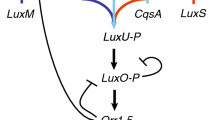Abstract
Several bacterial taxa change their behavior if the population density exceeds a certain threshold. This phenomenon is the consequence of a communication system between the bacteria and is called quorum sensing (QS). Up to now, this phenomenon is mostly modeled at population level. However, new experimental techniques allow for single cell analysis. We introduce a modeling approach for the description of this QS system, including a discussion of the regulatory network and its bistable behavior. Based on this single-cell model we develop and analyze a spatially structured model for a cell population. Special attention is given to the scaling behavior w.r.t. the cell size (leading to an approximation theorem for stationary solutions) and its consequences for the interpretation of cell communication (QS versus diffusion sensing). Concluding, we apply the modeling approach to spatially structured experimental data.
Similar content being viewed by others
References
Adams R., Fournier J. (2003). Sobolev Spaces. Elsevier, Amsterdam
Bassler B. (1999). How bacteria talk to each other: regulation of gene expression by quorum sensing. Curr. Opin. Microbiol. 2:582–587
Daniels R., Vanderleyden J., Michiels J. (2004). Quorum sensing and swarming migration in bacteria. FEMS Microbiol. Rev. 28:261–289
Dockery J., Keener J. (2001). A mathematical model for quorum sensing in Pseudomonas aeruginosa. Bull. Math. Biol. 63:95–116
Eberhard A., Burlingame A., Eberhard C., Kenyon G., Nealson K., Oppenheimer N. (1981). Structural identification of autoinducer of Photobacterium fischeri luciferase. Biochemistry 20:2444–2449
Fuqua C., Greenberg P.E. (2002). Listening on bacteria: acyl-homoserine lactone signalling. Nat. Rev. 3:685–695
Gantner, S.: Mikrobielle Ökologie N-Acyl-L-Homoserinlacton-produzierender Bakterien in der Rhizosphäre von Tomatenpflanzen. PhD Thesis, Ludwig-Maximilian-Universität München (2003)
Gray K., Greenberg E. (1992). Physical and functional maps of the luminescence gene cluster in an autoinducer-deficient Vibrio fischeri strain isolated from a squid light organ. J. Bacteriol. 174:4384–4390
Kaplan H., Greenberg E. (1985). Diffusion of autoinducers is involved in regulation of the Vibrio fischeri luminescence system. J. Bacteriol. 163:1210–1214
Koerber A., King J., Williams P. (2005). Deterministic and stochastic modelling of endosome escape by Staphylococcus aureus: “quorum” sensing by a single bacterium. J. Math. Biol. 50:440–488
Kuo A., Blough N., Dunlap P. (1994). Multiple N-acyl-L-homoserine lactone autoinducers of luminescence in the marine symbiotic bacterium Vibrio fischeri. J. Bacteriol. 176:7558–7565
Lupp C., Ruby E. (2004). Vibrio fischeri LuxS and AinS: comparative study of two signal synthases. J. Bacteriol. 186:3873–3881
Lupp C., Ruby E. (2005). Vibrio fischeri uses two quorum-sensing systems for the regulation of early and late colonization factors. J. Bacteriol. 187:3620–3629
Lupp C., Urbanowski M., Greenberg E., Ruby E. (2003). The Vibrio fischeri quorum-sensing systems ain and lux sequentially induce luminescence gene expression and are important for persistence in the squid host. Mol. Microbiol. 50:319–331
Miller M., Bassler B. (2001). Quorum sensing in bacteria. Annu. Rev. Microbiol. 55:165–199
Nealson K., Platt T., Hastings J. (1970). Cellular control of the synthesis and activity of the bacterial luminescent system. J. Bacteriol. 104:313–322
Ravn L., Christensen A., Molin S., Givskov M., Gram L. (2001). Methods for detecting acylated homoserine lactones produced by Gram-negative bacteria and their application in studies of AHL-production kinetics. J. Microbiol. Methods 44:239–251
Redfield R.J. (2002). Is quorum sensing a side effect of diffusion sensing? Trends Microbiol. 10:365–370
Renardy M., Rogers R.C. (1992). An Introduction to Partial Differential Equations. Springer, Berlin Heidelberg New York
Riedel K., Hentzer M., Geisenberger O., Huber B., Steidle A., Wu H., Hoiby N., Givskov M., Molin S., Eberl L. (2001). N-acylhomoserine-lactone-mediated communication between Pseudomonas aeruginosa and Burkholderia cepacia in mixed biofilms. Microbiology 147:3249–3262
Ruby E., Lee K.-H. (1998). The Vibrio fischeri-Euprymna scolopes light organ association: current ecological paradigms. Appl. Environ. Microbiol. 64(3):805–812
Schaefer A., Val B., Hanzelka B., Cronan J., Greenberg E. (2000). Detection, purification and structural elucidation of acylhomoserine lactone inducer of Vibrio fischeri luminescence and other related molecules. Method. Enzymol. 305:288–301
Sharma A., Sahgal M., Johri B. (2003). Microbial communication in the rhizosphere: operation of quorum sensing. Curr. Sci. 85:1164–1172
Steidle A., Sigl K., Schuhegger R., Ihring A., Schmid M., Gantner S., Stoffels M., Riedel K., Givskov M., Hartmann A., Langebartels C., Eberl L. (2001). Visualization of N-Acylhomoserine lactone-mediated cell-cell communication between bacteria colonizing the tomato rhizosphere. Appl. Environ. Microbiol. 67:5761–5770
Steidle A., Allesen-Holm M., Riedel K., Berg G., Givskov M., Molin S., Eberl L. (2002). Identification and characterization of an N-Acylhomoserine Lactone-dependent quorum-sensing system in Pseudomonas putida strain IsoF. Appl. Environ. Microbiol. 68:6371–6382
Thyson J., Othmer H. (1978). The dynamics of feedback control circuits in biochemical pathways. Progr. Theor. Biol. 5:1–62
Walter W. (1964). Differential- und Integral-Ungleichungen. Springer, Berlin Heidelberg New York
Ward J., King J., Koerber A., Croft J., Socket R., Williams P. (2004). Cell-signalling repression in bacterial quorum sensing. Math. Med. Biol. 21:169–204
Waters C., Bassler B. (2005). Quorum sensing: Cell-to-cell communication in bacteria. Annu. Rev. Cell. Dev. Biol. 21:319–346
Whitehead N., Barnard A., Slater H., Simpson N., Salmond G. (2001). Quorum-sensing in Gram-negative bacteria. FEMS Microbiol. Rev. 25:365–404
You L., Cox R.S. III, Weiss R., Arnold F.A. (2004). Programmed population control by cell-cell communication and regulated killing. Nature 428:868–871
Author information
Authors and Affiliations
Corresponding author
Additional information
Ch. Kuttler and J. Müller would like to dedicate this work to K.P. Hadeler, who not only introduced us to the fascinating field of mathematical biology, but also offered friendship and help at so many occasions.
Rights and permissions
About this article
Cite this article
Müller, J., Kuttler, C., Hense, B.A. et al. Cell–cell communication by quorum sensing and dimension-reduction. J. Math. Biol. 53, 672–702 (2006). https://doi.org/10.1007/s00285-006-0024-z
Received:
Revised:
Published:
Issue Date:
DOI: https://doi.org/10.1007/s00285-006-0024-z




